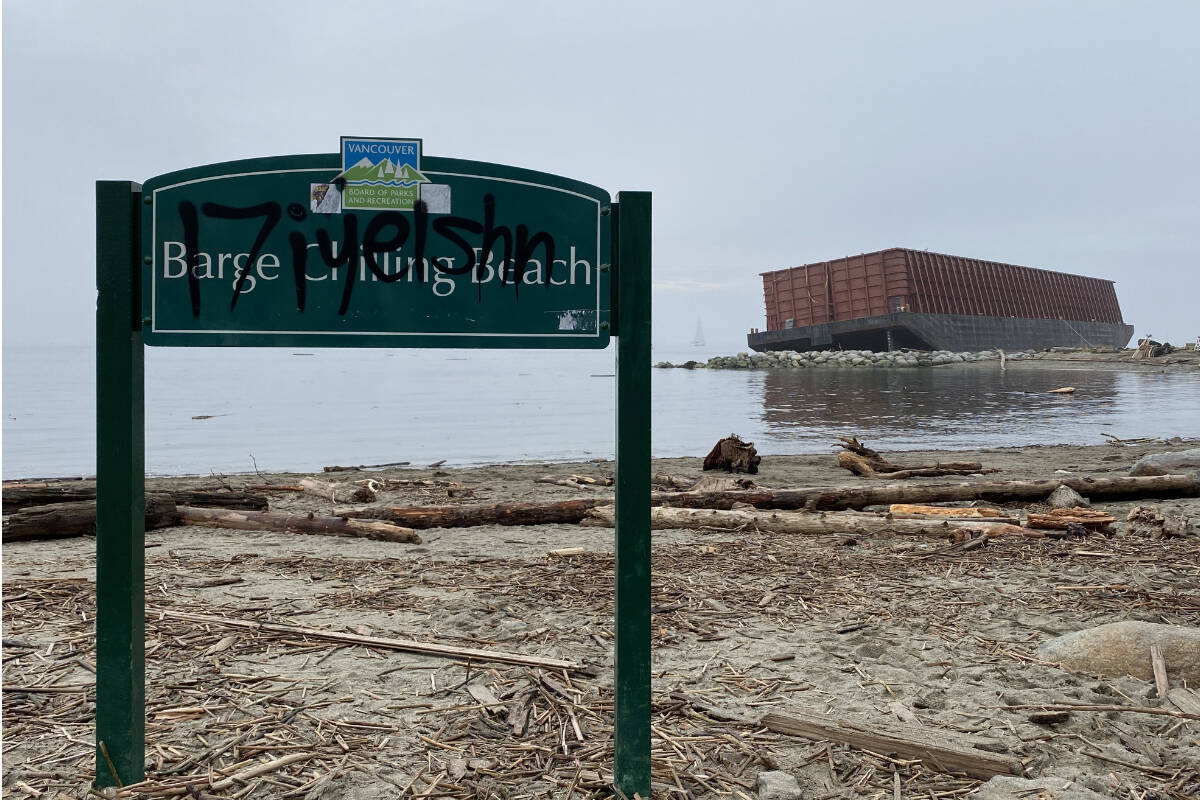If you haven’t seen it by now, a wayward barge “chilling” on a Vancouver beach is making waves on social media.
The barge washed ashore near Sunset Beach after the Nov. 14 atmospheric river event that caused widespread flooding and mudslides across B.C. Attempts to remove the beached barge have so far been unsuccessful and as of Jan. 19, there is no definitive date for when the barge will be moved.
The Vancouver Park Board seized the opportunity and temporarily dubbed the site “Barge Chilling Beach”, a nod to Vancouver’s famous “Dude Chilling Park”. On any given day, throngs of visitors can be seen gawking at the barge and taking selfies with the sign.
But the sign has generated more than just Instagram selfies as some on social media were quick to point out the beach already has a name — Í7iy̓el̓shn, which means “good underfoot” in hən̓q̓əmin̓əm, the language of the Musqueam and Tsleil-Waututh First Nations. The Squamish First Nation, whose territory extends into Greater Vancouver, speak Sḵwx̱wú7mesh.
“Now that this dumb barge got a sign…you CANNOT tell me it’s that hard to get some traditional place name signs around the cities,” Indigenous artist Ronnie Dean Harris said in a Facebook post.
Someone took it upon themselves to bring that conversation to the real world by spray painting Í7iy̓el̓shn over the sign. The sign was cleaned, but days later it was tagged again.
Black Press reached out to the Vancouver Park Board to ask why did a barge get a sign in a matter of weeks when it takes months — sometimes years — for signs with Indigenous place names to be installed.
READ MORE: Shift in perspective:’ Indigenous place names moving Canada from colonial past
Rena Soutar, manager of decolonization, arts and culture for the Vancouver Park Board said the process takes so long because there are multiple factors to consider when it comes to place naming.
“There are three Nations whose territory we’re on and three languages. One of the 11 reconciliation strategies the Park Board adopted in 2016 is acknowledging Indigenous language sovereignty, which is that the Nations should have control over when, where and how their language is used.”
When the Park Board creates signs with Indigenous place names, they consult with language and culture experts from Musqueam, Squamish and Tsleil-Waututh Nations to ensure the correct name is used in the correct language.
“One of the reasons this takes quite a while is place names aren’t that simple,” Soutar said. “The Nations, prior to colonization, may have had more than one name for a place depending on which families had access to that land, rights to it and used it. So, there’s a lot of consultation that has to be done to ensure all the families are in agreement about the name.”
Angela George, community development director for Tsleil-Waututh, said colonization and the residential school system undermined the hən̓q̓əmin̓əm language to the point that there are only four highly conversant speakers and no living fluent speakers.
“We are working diligently to restore and revitalize our language… It’s challenging with so few resources. And there’s a process we have to follow that people don’t fully understand. We can’t just throw names down.”
READ MORE: B.C. scholar says restoring Indigenous place names a step toward reconciliation
George said the process of restoring Indigenous place names involves researching the history of how the land was used and honouring that history.
“One location may have very deep-rooted history and usage for the people of the land historically and those names have always been there. The names are passed down through our oral tradition and sometimes that’s not recognized in today’s world. Our encyclopedias were held in our stories, our songs and in the artifacts that are connected to the lands and waters.”
Restoring Indigenous place names and Indigenous connections to the land will be an ongoing process that lasts much longer than the wayward barge parked at Í7iy̓el̓shn.
“The sign has served its purpose and now it’s serving a secondary good purpose and that is to spark this conversation,” Soutar said. “I’m observing what’s being said in the public discourse and all of that is going to inform our approach going forward.”
@SchislerCole
cole.schisler@bpdigital.ca
Like us on Facebook and follow us on Twitter.
Want to support local journalism? Make a donation here.

